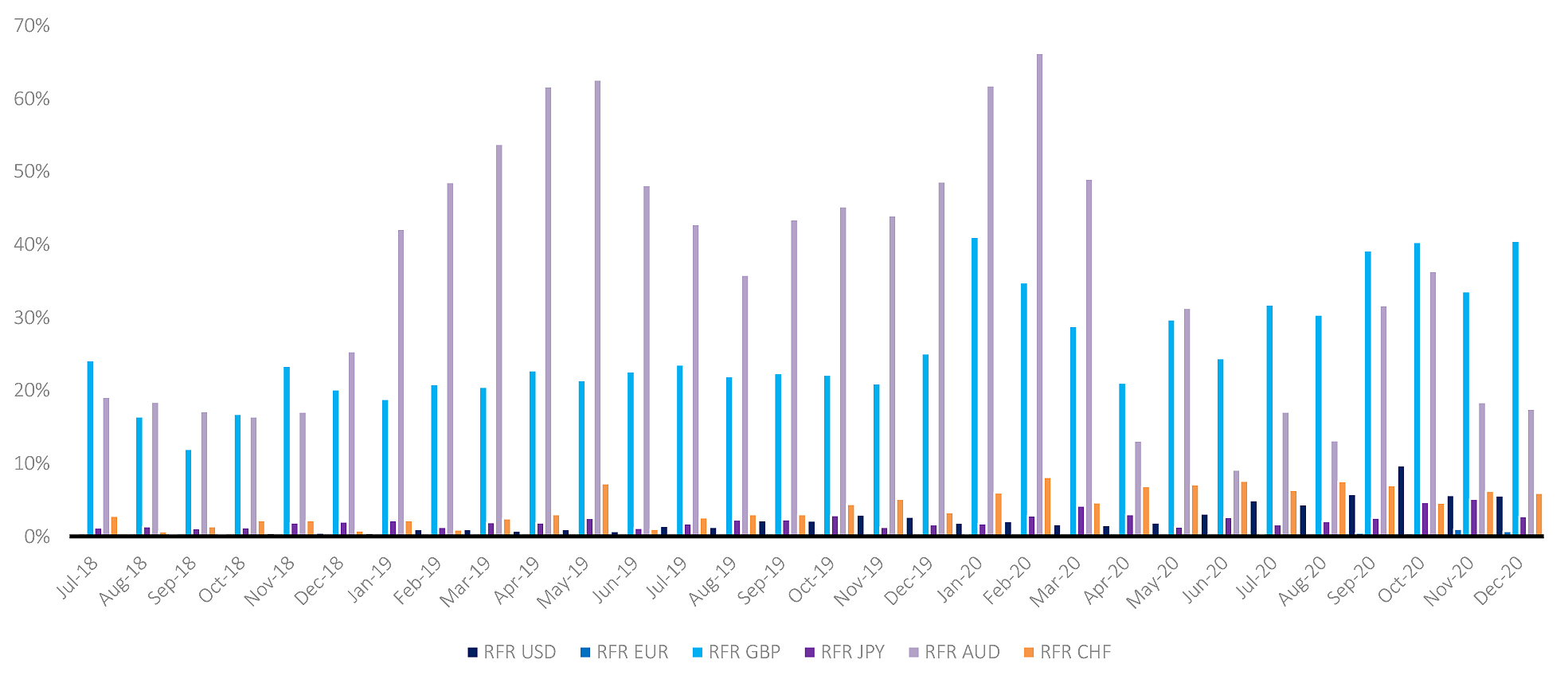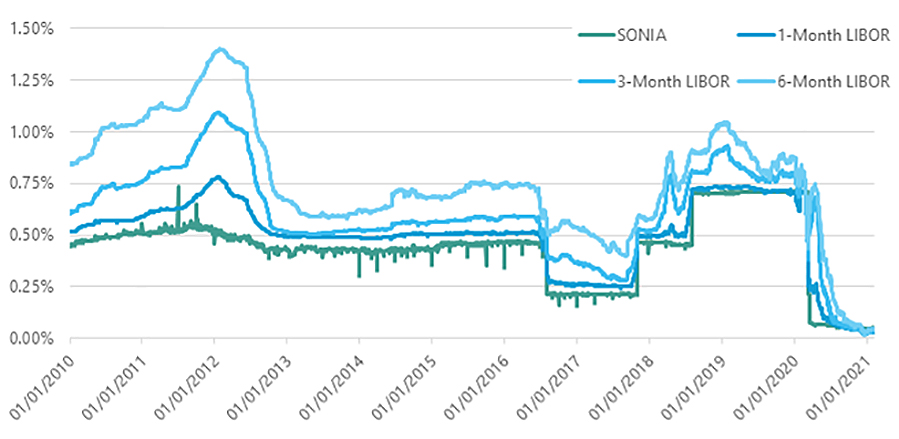The end of the London interbank offered rate at the end of this year is expected to have huge consequences for defined benefit schemes, which historically have been using it for different asset class investments and even for managers’ benchmarks.
Libor, which was tarnished by a price-fixing scandal with major banks fined billions of dollars for rate rigging in the mayhem of 2008, is finally being phased out 13 years later by the Financial Conduct Authority.
The Working Group on Sterling Risk-Free Reference Rates, which was established in 2015 to develop and adopt alternative risk-free rates, recommended the sterling overnight interbank average rate as an alternative to Libor two years later, and has been focused on how to transition to using Sonia across sterling markets since then.
Pension schemes may face difficulties in performing contracts that do not contain proper fallback mechanics once Libor ceases to be a widely used or supervised benchmark rate
Jonathan Gilmour, Travers Smith
After many years of preparation, 2021 is the critical year for companies to complete their transition away from Libor, as its administrator — ICE Benchmark Administration — is consulting on ceasing publication of all sterling Libor settings at the end of 2021, leaving just one year for companies to remove their remaining reliance on these benchmarks, the FCA stated.
Libor, a benchmark interest rate used to set interest rates and price derivatives, is part of the day-to-day activity of pension schemes, which use swaps linked to it to hedge their liabilities, as a discount rate for their liability cash flows or for some of their managers’ benchmarks.
According to Jeremy Rideau, Emea head of liability-driven investments at State Street Global Advisors, “while the changes are likely to appear niche and nebulous for many, they actually impact a very large number of investors in the industries across asset classes”.
In the pensions world, Libor features in “derisking arrangements (including longevity swaps and insurance policies), investment and fiduciary management agreements (particularly those used to pursue LDI and cash flow-driven investment strategies) and funding arrangements”, explained Jonathan Gilmour, partner and head of derivatives and structured products at Travers Smith.
He warned that if the Libor discontinuation is “improperly managed, it may cause disruption or have adverse financial implications for entities with Libor exposures”.
“Pension schemes may face difficulties in performing contracts that do not contain proper fallback mechanics once Libor ceases to be a widely used or supervised benchmark rate.”
Gilmour noted that other implications “could range from an economic impact (if the fallback rate chosen to replace Libor is less favourable), basis risk (if there is a mismatch between the fallback rate of a loan and the fallback rate of any hedging of the interest rate in respect of that loan), or, at worst, potential defaults under arrangements that apply an interest rate linked to Libor”.
Rate change is ‘storm in a teacup’
Danielle Markham, associate and head of LDI research at Barnett Waddingham, is more sanguine. “For the vast majority of pension schemes, we expect the abolition of Libor at the end of 2021 to be a storm in a teacup,” she said.
Parth Purohit, portfolio manager at Secor Asset Management believes the rate cessation should be manageable for UK pension schemes.
“At this point, the UK market seems more prepared for the transition than the US and EU,” he noted.
He pointed to data from the International Swaps and Derivatives Association, which showed that “Sonia-based swaps represented approximately 40.5 per cent of all [sterling] denominated interest rate derivative traded volume (in dv01 terms) in December 2020”.
The dv01 metric gives the dollar variation in a bond’s value per unit change in the yield
Percentage of dv01 per currency traded as an RFR-linked IRD product 
Source: International Swaps and Derivatives Association
But Hemal Popat, director at Mercer, warned that new “benchmarks will in almost all cases fall”, making them “easier to beat unless they are revised”, which will flatter performance.
The reason for this change is that many pension schemes use Libor for measuring investment performance. For example, three-month Libor plus 3 per cent a year is a common performance target, Markham explained.
She said that an issue can arise “when converting benchmarks from being Libor to Sonia-based, because Sonia is a lower interest rate than six or three-month Libor”.
This means that Sonia plus 3 per cent a year “is expected to be a less ambitious performance target” than Libor plus 3 per cent a year, she noted.
Lower Sonia rates compared with longer-dated Libor references commonly in place over the past 10 years (all rates annualised)

Source: Bank of England, ICE BofAML
Trustees using Libor “will need to renegotiate the benchmark for their derivative funds, and fundamentally renegotiating benchmarks with fund managers is quite a significant action, which could be the make or break of existing trustee arrangements with these current fund managers,” warned Penny Cogher, partner at Irwin Mitchell.
Residual problems lingering after Libor closure
The impact of the rate change would have been larger if it happened in the past when DB schemes were using Libor-based interest rate derivatives for liability hedging, said Dilesh Shah, head of LDI at Aon.
He added: “Over the past few years, our client base has been moving away from Libor interest rate swaps into gilts, and therefore in the LDI space there won’t be much impact.
“On the bonds/loans side there are still some bonds referencing Libor, but it is moving towards Sonia referencing.”
Shah said that ultimately, “the underlying beneficiaries of the scheme will not be affected by this change — funding levels won’t have changed and employer contributions will remain the same”.
Investment managers such as Insight Investment and Legal & General Investment Management concur with this analysis.
Anne-Marie Morris, senior solutions strategy manager at LGIM, noted that the company has been working on this issue with its clients over a number of years.
“Most of our clients no longer have Libor-referencing derivatives and instead have ones referencing Sonia,” she said.
RPI reform boosts inflation hedging
The announced reform of the retail price index, to match the consumer price index including housing costs, saw inflation hedging rise by six per cent quarter on quarter at the end of September 2020.
“DB pension schemes with residual Libor derivatives need to ensure that appropriate interbank offered rate fallback protocols are in place, or that another renegotiation has taken place.”
Problems could still rumble on for some time yet as Robert Gall, head of market strategy at Insight Investment, pointed to the “tough legacy issue”.
“This is where pre-existing contracts (typically bonds and loans) referencing Libor and expiring after 2021 cannot be transitioned into alternative rates,” he said.
“We are expecting the synthetic Libor solutions that the FCA is working on to help towards this.”






















